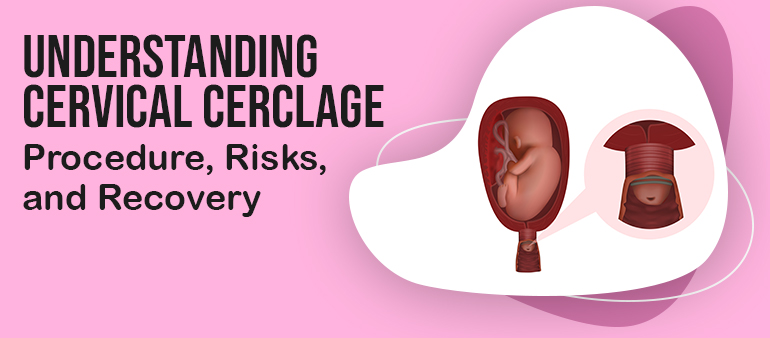
Understanding Cervical Cerclage: Procedure, Risks, and Recovery
Cervical cerclage is a way of keeping your cervix closed during pregnancy to prevent premature birth due to incompetent (weakened) cervix. If your cervix has weakened, your healthcare provider will likely recommend a cervical cerclage. This is to keep the fetus safe inside of your uterus until it’s time for you to give birth.
What is cervical cerclage?
Cervical cerclage is a way of keeping your cervix closed during pregnancy to prevent premature birth due to incompetent (weakened) cervix. If your cervix has weakened, your healthcare provider will likely recommend a cervical cerclage. This is to keep the fetus safe inside of your uterus until it’s time for you to give birth.
During this procedure, your healthcare provider will place one or several sutures (stitches) in the opening of your cervix to keep it safely closed during your pregnancy.
Your cervix is the lower portion or opening of your uterus. Your uterus is like a pouch or purse, and a cervical cerclage procedure is like strings that keep the purse closed.
When Is It Done?
If your doctor recommends a cervical stitch because you’ve had problems with a previous pregnancy, it should ideally be done 12 to 14 weeks into your pregnancy. If the procedure is done after this time, it’s called an emergent cerclage. If you’ve had an emergent cerclage, you have a greater chance of needing another cerclage if you get pregnant again. Otherwise, you can have the surgery up to 24 weeks. Past that date, a cervical stitch could cause the amniotic sac to rupture and make your baby come too soon.
Why is cervical cerclage performed?
There are several reasons why your healthcare provider may recommend cervical cerclage during your pregnancy. Some reasons for cervical cerclage include:
- Incompetent (weakened) cervix. This can happen due to past surgeries such as LEEP procedures or other surgeries on cervical tissue.
- Past miscarriages from an abnormally shaped uterus or damage to your cervix.
- Past miscarriages during the second trimester that suggest weakened cervix.
It’s important to discuss with your healthcare provider any past pregnancies, miscarriages and procedures you’ve had. If your healthcare provider thinks you may benefit from a cervical cerclage procedure, they’ll perform it at about 12 to 14 weeks into your pregnancy, before your cervix thins out.
What happens before a cervical cerclage procedure?
Before your cervical cerclage procedure, your healthcare provider will go over your health history and discuss with you any past complications from pregnancies or surgeries you may have had on your cervix.
They’ll examine your cervix prior to the procedure by placing a speculum inside of your vagina so they can see your cervix clearly, similar to when you have a routine Pap exam. They may also do a transvaginal ultrasound. Your healthcare provider will likely ask you to abstain from sexual intercourse for a week prior to your procedure.
It’s normal to feel nervous or have questions before having a cerclage procedure. During this time, it’s a good opportunity to ask your healthcare provider any questions or talk through any concerns you may have.
When is it Not Recommended?
Even if your cervix starts to widen too early, a cervical stitch may not be right for you if you also have any of the following:
- Preterm labor
- Vaginal bleeding
- An infection in your uterus
- A fetal anomaly that makes it unlikely your baby will live
- Your amniotic sac, sometimes called the bag of waters, leaks or breaks before 37 weeks of pregnancy.
- Your amniotic sac bulges through the cervix (prolapsed fetal membrane).
- You’re pregnant with two or more babies (high-order pregnancy).
What happens during a cervical cerclage procedure?
During your cervical cerclage procedure:
- You’ll lie back on an examination table with your legs open and both of your feet in stirrups similar to when you have a vaginal exam.
- Your healthcare provider will give you some pain-numbing medication, such as a local anesthetic, so you won’t feel any pain or discomfort during the procedure. You may feel a small pinch when the needle is inserted into your cervix to numb it.
- After the anesthesia takes effect, your healthcare provider will stitch your cervix closed with strong sutures, tightening it until it’s secure.
Is a cervical cerclage procedure painful?
It’s normal to feel some cramping and light bleeding or spotting for a few days after the procedure. You shouldn’t feel much pain after having a cervical cerclage procedure - no more than an average menstrual period. You can take acetaminophen (Tylenol®) to ease any cramping or discomfort. If you do have intense abdominal cramping or pain, call your healthcare provider right away.
What happens after this procedure?
After your procedure, you’ll stay at your healthcare provider’s office or the hospital for a couple of hours to make sure you don’t have any complications. You’ll go home the same day. Your healthcare provider may give you an antibiotic to take to prevent any cervical infection.
You should plan to rest the day of your procedure and not attend school or work. Your healthcare provider will want you to allow plenty of time for your stitches to heal — about 10 days — before you engage in any strenuous exercise or sexual intercourse. It’s important to follow your healthcare provider’s aftercare instructions and keep any follow-up appointments so they can monitor your pregnancy.
What are the advantages of cervical cerclage?
It’s always wise to thoroughly discuss with your healthcare provider your options if you’re at high-risk for preterm labor. But if you have a weakened cervix, a cervical cerclage procedure is the best way to prevent preterm labor (labor that begins before 37 weeks). The advantages are clear.
What are the risks or complications of having a cervical cerclage procedure?
Your healthcare provider will only recommend a cerclage procedure if the benefits outweigh the risks. But, as with almost any medical procedure, there are some risks to be aware of with a cervical cerclage procedure. These include:
- Infection.
- Damage to your cervix.
- Bleeding.
- Premature rupture of membranes. This means your water breaks before it should. The fetus rests inside of your uterus in amniotic fluid, also called “bag of water” or “membranes.” The rupture of your membranes could trigger preterm labor.
- Preterm labor.
- Cervical stenosis (permanent narrowing of your cervix).
- Scar tissue on your cervix.
- Tearing of your cervix or uterus if labor progresses while sutures are still intact.
What things should I not do after a cervical cerclage procedure?
Your healthcare provider will want you to take it easy for a week to 10 days after your cerclage procedure to allow time for your cervical stitches to heal properly. During this time, it’s important for you to follow their instructions. They’ll likely advise you to:
- Abstain from sexual intercourse or inserting anything inside of your vagina such as douches or other feminine products.
- Take it easy. Refrain from strenuous exercise or lifting heavy objects.
Is it OK to have sex after a cervical cerclage procedure?
Your healthcare provider will want you to abstain from sexual activity for a week before your cervical cerclage procedure and probably for a week to 10 days after your procedure to allow your cervical stitches time to heal.
When can I go back to work or school after a cervical cerclage?
Cervical cerclage is an outpatient procedure typically performed by your healthcare provider in their office or a hospital setting. People can return to normal activities such as work or school the next day.
When is a cervical cerclage removed?
Your cerclage will stay in place until your pregnancy reaches full term or about the 37th week of pregnancy. When it comes time to remove your cerclage, you’ll follow many of the same steps as when you had your cerclage placed. Your healthcare provider will remove your cerclage in their office where:
- You’ll lie back on an examination table with your legs open and both of your feet in stirrups similar to when you have a vaginal exam.
- Your healthcare provider will remove the stitches from your cervix.
The removal procedure should only take a few minutes. Your cerclage can be removed sooner if your water breaks or you go into labor.
When should I call my doctor after cervical cerclage?
Call your healthcare provider right away if you experience any of the following:
- A high fever (over 100 degrees Fahrenheit [37.7 degrees Celsius]).
- Contractions or lower abdominal pain that comes at regular intervals.
- Foul-smelling vaginal odor or discharge.
- Water breaking or leaking.
- Excessive bleeding.
Cervical Cerclage Results
Doctors don’t all agree on how well cervical cerclage works. If you definitely have a weak cervix (cervical insufficiency), it will most likely lower your chances of a premature delivery. But progesterone shots may work as well.
How well cervical cerclage works depends a great deal on when you have it done. If it’s done in an emergency, when your cervix has already changed size or shape, it’s less likely to work.
A Note from Gynae Clinic
It’s natural to feel frightened or have questions if you need to have a cervical cerclage procedure. While it might be scary to consider cerclage treatment, this procedure is successful in nearly 90% of cases. But people diagnosed with short or incompetent cervix in a pregnancy can have this condition in subsequent pregnancies. Talk openly with your healthcare provider about how to plan for a healthy pregnancy. Ask them any questions you have and talk through your concerns.
